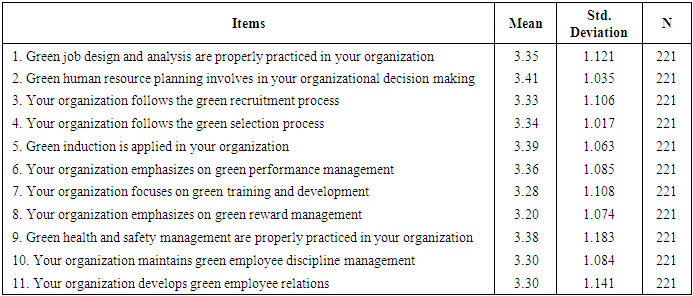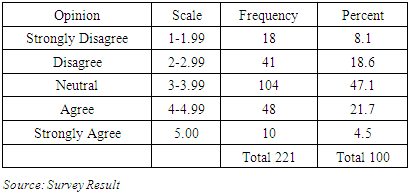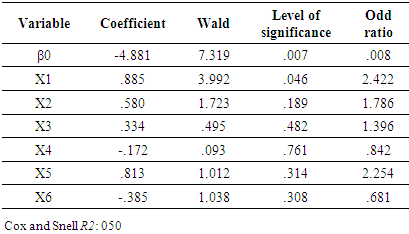-
Paper Information
- Paper Submission
-
Journal Information
- About This Journal
- Editorial Board
- Current Issue
- Archive
- Author Guidelines
- Contact Us
Human Resource Management Research
p-ISSN: 2169-9607 e-ISSN: 2169-9666
2019; 9(1): 14-21
doi:10.5923/j.hrmr.20190901.03

An Analysis of Employee Awareness on Green Human Resource Management Practices: Evidence from Bangladesh
Mohammad Abdullah Al Mamun
Assistant Professor, Southeast Business School, Southeast University, Dhaka, Bangladesh
Correspondence to: Mohammad Abdullah Al Mamun, Assistant Professor, Southeast Business School, Southeast University, Dhaka, Bangladesh.
| Email: |  |
Copyright © 2019 The Author(s). Published by Scientific & Academic Publishing.
This work is licensed under the Creative Commons Attribution International License (CC BY).
http://creativecommons.org/licenses/by/4.0/

Purpose – The purpose of this study is to examine the extent of awareness of Green Human resource Management among different levels of HR Managers from various organizations in Bangladesh. Design/methodology/approach – A combination of quantitative and qualitative research methods are employed to gather information. Specifically, data are collected from 221 managers in selected firms. Descriptive data analysis is presented with respect to the awareness level and causal research approach executed to find out the significant factors which increase the employees’ awareness on green HRM. Findings – This study provides significant current information on Green HRM though the practice of Green HRM in Bangladesh is insignificant. The findings reveal that Green HRM knowledge depends on various factors. Practical implications – The study identified the awareness level on Green HRM among the Managers from different sectors in Bangladesh. Organizations should employ requisite Green HRM practices to achieve excellent organizational performance. Furthermore, the government may create policies to promote the above practices, since, in the long term, achieving organizational excellence will reflect positively on the economy. All these may be facilitated through proactive organizational and national human resource development initiatives. Originality/value – The significance of the present study stems from the fact that very few studies have explored the awareness level of employees in the field of Green human resource management in Bangladesh. The results provide additional insights into HRM practices in Bangladesh, as an Indian subcontinent country. A region that has been neglected by management researchers and has therefore been less researched. Also, the insights gained from this study contribute to the future development of this line of research, particularly in a non-Western country like Bangladesh.
Keywords: Green Human resource management, Awareness, Sustainable Environment, Strategic Human Resource Management
Cite this paper: Mohammad Abdullah Al Mamun, An Analysis of Employee Awareness on Green Human Resource Management Practices: Evidence from Bangladesh, Human Resource Management Research, Vol. 9 No. 1, 2019, pp. 14-21. doi: 10.5923/j.hrmr.20190901.03.
Article Outline
1. Introduction
- Since the 1990s, the environmental management area has been facing a challenging but promising journey through companies; and the issue of environmentalism has also globally arisen from specific treaties to combat climate change, e.g. Kyoto 1997, Bali 2007 and Copenhagen 2009 (Victor, 2001). Such journey has resulted in several practices and procedures aimed at making companies greener (Jose Chiappetta Jabbour, 2011). Hence the organizations have emphasized more to find out techniques to deal with reduction in ecological footprints besides dealing with the economic issues. In order to attain success within the corporate community and to facilitate attainment of profit by the shareholders, organizations nowadays have to concentrate on social and environmental factors along with economical and financial factors (Daily, Bishop, & Steiner, 2007). The successful implementation of these sustainable corporate strategies within an organization requires both strong leadership and a concrete process (Glavas, Senge, & Cooperrider, 2010). The sustainability issue is fast moving up on the list of priorities of the leaders of corporate world as the awareness on incorporating “green” into the corporate strategy is making its way in business, but still the topic is not comfortable with most practitioners in the HR environment (Wirtenberg, Harmon, Russell, & Fairfield, 2007). Greening is a holistic process aimed at smarter energy usage, low costs, low wastage using sustainable resources or recyclable materials for end results that are products, targets etc. which are environmentally friendly. Studies have indicated that going green is economically useful, has a direct impact on bottom line profits where business is concerned and actually enhances return on investments (Jafri, 2012).What is Green Human Resource Management (GHRM)?GHRM is responsible in creating green workforce that understands, appreciates, and practices green initiative and maintains its green objectives all throughout the HRM process of recruiting, hiring, training, compensating, developing, and advancing the firms’ human capital (Mathapati, 2013). It refers to the policies, practices, and systems that make employees of the organization green for the benefit of the individual, society, natural environment, and the business (Opatha & Arulrajah, 2014). Green HRM involves two essential elements: environment friendly HRM practices and preservation of knowledge capital (Jain, 2009). Green HRM also involves reducing carbon footprint via less printing of paper, video conferencing and interviews, etc. Who is Green Employee? An employee who is nature lover, eco-activist, non-polluter, preservationist and conservationist of resources of the organization. To identify green employee in organization, the following questions should be asked: Ÿ Does he switch off his computer when he finishes work?Ÿ Does he use a mug rather than disposable cups?Ÿ Does he print out his emails on both sides of the paper?Ÿ Does he use public transport or walk/cycle to work?Ÿ Does he recycle any garbage/rubbish he creates at work? Ÿ If he is the last to leave, does he make sure all unnecessary lights and equipment are switched off?Rationale of the studyGreen HRM initiatives help companies find alternative ways to cut costs without losing their top talent and promote sustainable business practices. It may help the employers in building brand image and reputation. Green HRM will make employees and society members aware of the utilization of natural resources more economically and encourage eco-friendly products. It also emphasizes long-term employment security is to avoid disruption for employees, their families and communities. This is why to increase the employee awareness on Green HRM is stipulate for the modern competitive business world. Objectives of the study Broad ObjectiveThe broad objective is to analyze the awareness level of the employees about the Green HRM practices.Specific Objectives 1) To assess the awareness of Top level HR manager about Green HR practices. 2) To assess the awareness of Mid-level HR manager about Green HR practices. 3) To assess the awareness of Junior HR employees about Green HR practices.4) To identify the factors that increase awareness on Green HRM of employees. HypothesesH1: Top level HR managers are not aware of Green HR practices. H2: Mid level HR managers are not aware of Green HR practices. H3: Junior HR employees are not aware of Green HR practices.
2. Literature Review
- Milliman and Clair (1996) were among the first to propose an exploration of the great role of HRM in environmental management. They built a model of Environmental HRM practices involving four main steps. First, a firm requires an environmental vision as a guideline for shaping its strategy. Second, employees must be trained to understand the firm’s philosophy of environmental vision through its goals and strategy. Third, employee environmental performance needs to be evaluated using an appropriate appraisal system in line with these goals. Four, recognizing pro-environmental activities carried out in the workplace. Renwick et al. (2013) also summarized three core components of the HR aspects of environmental management (EM). The first core component is related to the development of green abilities and implies practices such as selecting, recruiting, training and developing environmental knowledge, and encouraging EM leadership. The second core component is related to the motivation of green employees and implies appraisal and rewards. The third core component is related to the stimulation of employee involvement and implies valorizing tacit knowledge, empowering employees, and creating a green organizational culture.The Green HRM literature is largely a western one and, given the importance of Asian economic development for environmental management, this is an important gap for future studies to reduce (Renwick, Redman, & Maguire, 2013). Scholars of management around the world are now analyzing various managerial practices that can facilitate the achievements of the goals of GHRM and also have a significant impact on the environmental competitiveness of the organizations.In 21st century, HR professionals should deploy the Green cues in traditional HR functions to ensure the sustainable environment and to gain the competitive advantage of the organization. The following subdivision presents synopsis of the new green HRM practices under each function of HRM.
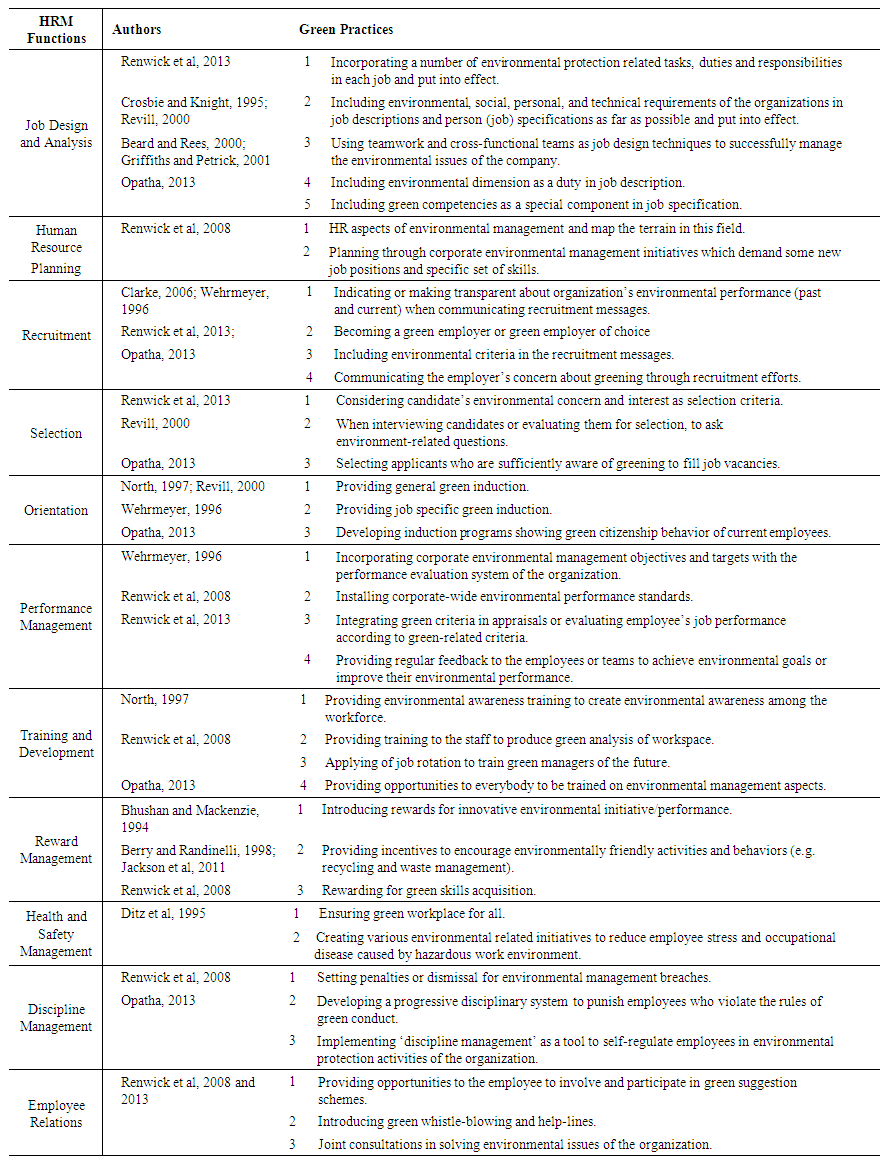 | Table |
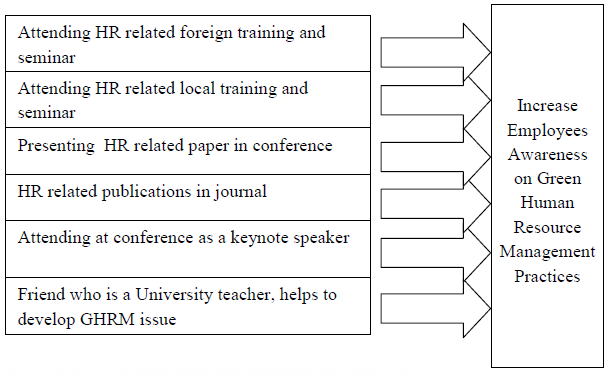 | Figure 1. Factors to increase employee awareness on Green HRM |
3. Methodology
- Quantitative methods are basically reported in numeric values, while qualitative methods of research are reported in rich descriptive form (Saunders, 2009; Denzin and Lincoln, 2000). The most prominent difference between qualitative and quantitative method of research is the treatment of its analysis, as quantitative formulates and determine the hypothesis, it also tries to find out relationships between hypothesis before actual research is carried out, while qualitative is more of finding and formulating the hypothesis during the process of research (McCracken, 1988). With the aforementioned differences highlighted above this research is on ‘Employees awareness on Green Human Resource Management Practices’ and for analyzing the awareness generating hypothesis and testing are important and using statistical tools are mandatory, Primarily quantitative research method is employed and qualitative method is also introduced. Descriptive statistics and logistic regression method applied in this study respectively to know the awareness about Green HRM among the managers and to identify the significant factors that influenced on employees awareness about Green HRM. Sources of dataTo conduct this research primary sources of data are used. A structured questionnaire has been developed based on the literature study and experts’ opinion and survey has been conducted to various levels of HR managers in different kinds of organization. Informal interviews are also conducted with various levels of HR managers. Sampling designSimple random sampling is used to survey questionnaires on 221 respondents, which includes Top level, Mid level and Junior level HR Managers from Telecommunications, Financial institutions, Pharmaceuticals, Readymade garments, Services, NGOs, Information Technology, Manufacturing, Real States and FMCGs; as we know majority of the companies from these industries are contributing more in the national economy of Bangladesh.Technique of Data Analysis The collected data is analyzed through SPSS version 20 software. Frequency table is prepared to analyze the number of respondents’ certain answer. Crosstabulation technique is applied to joint frequency distribution of cases based on two or more categorical variables. Reliability and internal consistency of data is checked through the measurement of Cronbach Coefficient Alpha. The binary logistic regression model is used to estimate the probability of a binary response based on one or more predictor (or independent) variables (features).
4. Findings and Analysis
- Analysis part of this study begins with descriptive form of discussion where researcher has observed that 81% (table 1) of Managers from various industries in Bangladesh are aware of green HR and among them 55% (table 2) employees have mentioned that their organizations are holding a formal policy to execute Green HR practices.
|
|
|
|
|
|
|
|
5. Conclusions
- This study shows that majority of the HR managers from different industries in Bangladesh are aware of Green Human Resource Management. However, proper Green HR activities are not yet practiced in the organization. Hence, organizations want to execute the Green HR policy in near future. Foreign training and seminars are significant factors to increase the awareness about Green human resource management among various levels of HR managers in the organization. To enhance the Green human resource management practices, Government should incorporate Green human resource management practice in Bangladesh labor law as well as promote the organizations who practice green HRM. In addition, Universities should introduce green HRM in their syllabus. Furthermore, organizations should develop strategic human resource management policy based on Green HRM concept, specially promote green employee in the organization. In 21st century, HR professionals should deploy the Green cues in traditional HR functions to ensure the sustainable environment and to gain the competitive advantage of the organization. The people in the organizations also must realize the importance of Green Movement, Green HR and Green Audit. The responsibility of the present generation HR Managers is to incorporate the Green HR Philosophy in corporate mission statement, HR-Polices. The major barrier in front of HR professionals is to realize the capacity and profundity of green HRM in converting their organizations as green unit. In this context, the responsibility of the present generations, HR managers is to create awareness among the youngsters and among the people working for the organization about the Green HRM, Green Movement, utilization of natural resources and helping the corporate to maintain proper environment, and retain the natural resources for our future generation i.e. sustainable development.
ACKNOWLEDGEMENTS
- The author would like to acknowledge the financial support to conduct the research provided by Institute of Research and Training (IRT) of Southeast University, Dhaka, Bangladesh.
Appendix
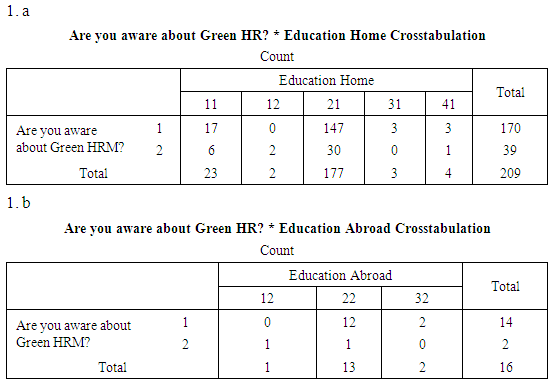
 Abstract
Abstract Reference
Reference Full-Text PDF
Full-Text PDF Full-text HTML
Full-text HTML



